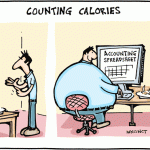A missing aspect in most people’s approach to health and fitness is the idea of a target, an end, or at least a goal that you could call completion.For many, the idea of ‘completion’ of their weight loss and muscle building goals is almost blasphemy. Most people approach fitness under the concept of CONTINUALLY losing fat and gaining muscle, because they don’t want to think about the idea of an end.Without diving deep into a discussion on genetics and phenotypes, let’s just agree that their is such a thing as an Ideal body for you.Lets also agree that we can all move close to our ideal body, and this ideal is defined by the limits of our own individual bodies.For some reason it’s not ‘right’ or ‘correct’ to talk about an ideal shape or an ideal body, even though we have a large body of evidence that this very thing exists. Instead, we’re supposed to all be happy at any shape or size, of body fat, or muscle mass…and somehow the message of ‘be happy’ has been mutated into “don’t strive to improve, and think poorly of those who suggest that improvement is possible” leading to the inability to fathom the idea there even being a true ideal.But an ideal does exist. Anthropometric data (body measurements) on professional athletes and body transformation winners, combined with military data all all point to a very specific shape that signifies and ideal, healthy body. We may not all be able to hit the goal, but we can all get very close to it by using exercise and diet as treatment – In this way, exercise and diet are corrective.Accepting that there is an ideal or a goal body that represents a true ‘finish line’ leads to the philosophy that the farther you are from this ideal, the more severe the treatment needs to be, but the closer you get the less severe the treatment becomes. Very similar to treating being ‘out of shape’ as a form of sickness – you treat the sickness, but once it’s gone you switch to attempting to prevent it from coming back.The point is to move from harder to easier, to the point where you are simply fine tuning the result… putting in the amount of effort needed to maintain, maybe tinkering with the process a bit, but not purposelessly putting in more and more effort in the hopes of achieving a goal that is not measurable or describable.Once you realize there is a point where you are no longer ‘sick or broken’ that you are OK, Fine, even… done, then you can you train less and eat more of what you want. This entire approach can be ruined by the concept of ‘Sick mentality’ which I learned about from some friends who have gone through cancer treatment.With cancer patients one of the most important things is to stay positive through your chemotherapy.
Continue reading here:
My Philosophy of Fitness | Brad Pilon's 'Eat Blog Eat'















 For now classes are 6pm and 640pm at 2840 Wildwood st in the Boise Cloggers studio.
Book your class NOW!
click this ==>
For now classes are 6pm and 640pm at 2840 Wildwood st in the Boise Cloggers studio.
Book your class NOW!
click this ==>








